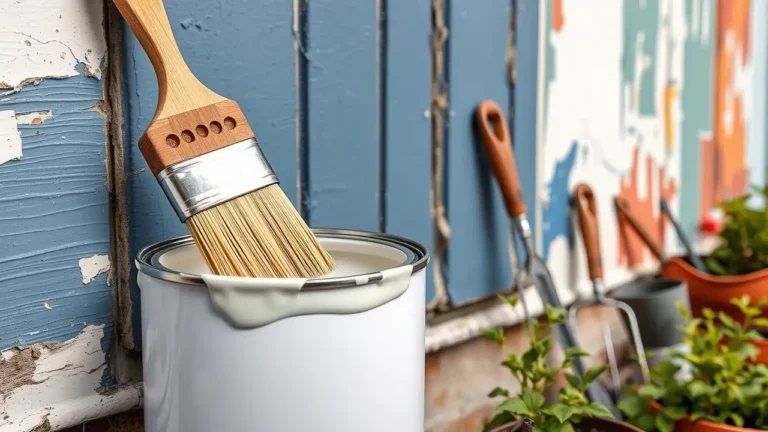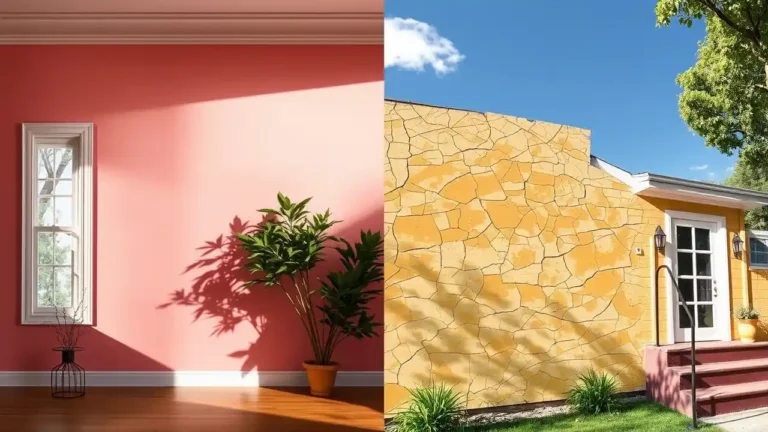Can Interior Paint Be Used Outside? It’s a common question with a clear answer: not if you want your paint job to last.
Interior paint isn’t made to handle sun, rain, or temperature swings.
This post will explain why it matters, what to use instead, and how to avoid costly outdoor paint mistakes especially in climates like San Diego.
Table of Contents
Can I Use Interior Paint Outside?

Technically, yes you can put interior paint on an outdoor surface.
But just because you can doesn’t mean you should.
Here’s why: interior paint isn’t made for outdoor elements like UV rays, moisture, or temperature changes. It might look fine for a few days, but it won’t last.
Imagine this: A homeowner paints their patio with leftover interior paint. It looks fresh at first. But within weeks, it starts fading, cracking, and eventually peeling. That’s money and time down the drain.
Interior paint for exterior use just doesn’t hold up. The ingredients in the formula aren’t strong enough for outside.
What is the Difference Between Interior and Exterior Paint?
Paint types are purpose-built. Each is formulated for its specific environment. The distinctions between interior and exterior paint are crucial.
Key Distinctions (Comparison Focus):
- Durability & Resilience: Exterior paints are engineered to withstand harsh weather. This includes rain, snow, humidity, and extreme temperature changes. They also resist UV radiation. Interior paints are designed for abrasion resistance and washability. They focus on aesthetic appeal in controlled indoor spaces.
- Flexibility: Exterior paint contains flexible binders. These allow it to expand and contract with temperature shifts. This prevents cracking and peeling over time. Interior paint is less flexible. It does not need to handle significant thermal movement.
- Mold, Mildew, and Fungi Resistance: Exterior paints contain fungicides and mildewcides. These inhibit growth in damp outdoor conditions. Interior paints generally lack these additives. Indoor environments are less prone to such issues.
- UV Resistance & Color Retention: Exterior paint pigments and binders resist fading. They also prevent chalking from prolonged sun exposure. Interior paint is not designed for UV exposure. This leads to rapid fading and discoloration outdoors.
- VOCs (Volatile Organic Compounds) & Odor: Interior paints often have lower volatile organic compounds (VOCs). This improves indoor air quality and reduces odor. Exterior paints can have higher VOCs due to performance additives. However, many low-VOC exterior options are now available.
- Adhesion & Surface Preparation: Each paint type interacts differently with surfaces. Exterior paints are made to bond strongly to outdoor materials. This includes wood, stucco, and metal. Interior paints adhere well to typical interior walls.
What Happens if I Use Interior Paint Outside?

If you decide to use interior paint for exterior projects, prepare for rapid deterioration. What happens if you use interior paint outside is a quick decline in your project’s appearance and integrity.
Rapid Deterioration:
- Fading and Discoloration: Sun exposure quickly degrades interior pigments. Your vibrant color will become dull fast.
- Cracking and Peeling: Lack of flexibility causes immediate structural failure. As temperatures change, the paint will crack. It will then start to peel away from the surface. This is why using interior paint on exterior surfaces is a bad idea.
- Blistering: Moisture penetration causes bubbles. These bubbles lead to delamination, where the paint separates from the surface.
- Chalking: The paint surface breaks down. It forms a powdery residue that rubs off easily.
Vulnerability to Elements:
- Mold and Mildew Growth: Interior paint lacks protective additives. This leads to unsightly and damaging organic growth. Outdoor moisture encourages this.
- Moisture Damage: Poor water resistance allows moisture to penetrate. This can damage the underlying substrate. Wood can rot, and masonry can crumble.
Aesthetic Failure:
The result is an unsightly appearance. You will see an uneven finish and greatly reduced curb appeal. Your paint job will look bad quickly.
Increased Costs and Effort:
Using the wrong paint means more work and money. You will need premature repainting. Extensive surface preparation will be needed to remove the failed paint. This wastes both time and money. It’s simply not worth it.
What is the Best Paint for Exteriors?
To ensure a long-lasting and beautiful finish, choose a paint made for outdoor use. Exterior paints are specifically formulated for durability.
Key Characteristics to Look For:
- 100% Acrylic Latex: This is highly recommended. It offers excellent flexibility, durability, and resistance to fading. It also prevents cracking and peeling. This type of outdoor paint is often water based paint, making cleanup easy.
- Oil-Based Paints: These are still used for specific applications. They are good for trim, metal, or over existing oil based paint. They are known for hardness and durability. However, they are less flexible than acrylics.
- Specific Additives: Look for paints with UV inhibitors. These protect against UV rays. Mildewcides are also important. Dirt-resistant technologies help keep your surfaces clean.
- Sheen Levels: Different sheens impact outdoor durability and cleanability. Flat sheens hide imperfections but are harder to clean. Satin offers a slight sheen and is easier to clean. Semi-gloss is very durable and easy to clean, often used for trim.
Considerations for Different Surfaces:
The best paint depends on the surface. Different paints work best for wood, stucco, masonry, metal, and siding. Always check the paint label for specific surface recommendations.
The Role of Primer:
Always use a high-quality exterior primer. Primer improves adhesion. It also blocks stains and ensures a uniform finish. This step is vital for any successful exterior painting project.
The Importance of Choosing the Right Paint for Your Project
Selecting the correct paint is not just about color. It is about protecting your investment. The right paint offers longevity and protection.
- Longevity and Protection: The correct paint acts as a protective barrier. It extends the life of your home’s exterior surfaces. It shields them from the outdoor elements and harsh weather.
- Enhanced Curb Appeal: A well-painted exterior significantly boosts your property’s aesthetic value. It makes your home look well-maintained and inviting.
- Cost-Effectiveness in the Long Run: Investing in the right paint upfront saves money and effort. It avoids frequent repainting and costly repairs. You won’t have to deal with eventually peeling paint.
- Preventing Structural Damage: Proper exterior paint prevents moisture intrusion. Moisture can lead to rot, mold, and other expensive structural issues.
- Warranty Compliance: Using the specified paint types can be crucial. It helps maintain product and material warranties on your home’s surfaces.
Need Something Painted?
Don’t want to tackle the job yourself? Consider professional painting services. San Diego Home Remodeling offers expert Painting Services in San Diego. Our professional painters ensure a high-quality finish. We provide expertise, efficiency, and peace of mind. Contact us today for a quote or consultation.
FAQs: Can Interior Paint Be Used Outside?
What happens if you use interior paint outdoors?
Interior paint used outdoors will quickly fade, crack, peel, and blister. This is due to a lack of UV resistance, flexibility, and protection against moisture and mildew. It will fail to protect the surface. You will need to repaint much sooner. This answers the question, will interior paint work outside? No, it will not.
How long will interior paint last outside?
Interior paint used outside will typically last only a few months, or even weeks. It will show significant signs of failure like peeling, cracking, and fading. It is not designed to withstand outdoor elements for any extended period.
How to turn interior paint into exterior paint?
You cannot effectively “turn” interior paint into exterior paint. They have fundamentally different chemical compositions, binders, and additives. Attempting to modify interior paint for outdoor use will not provide the necessary durability or protection. This will lead to premature failure. Paints are specially formulated for their intended use.
Can interior paint sit outside?
Yes, interior paint cans can sit outside if properly sealed. They must also be protected from extreme temperatures (freezing or excessive heat) and direct sunlight. However, this refers to storage, not application. The paint itself is still only suitable for interior use.
Can normal paint be used outside?
“Normal paint” typically refers to standard interior paint. No, normal interior paint cannot be used outside. Outdoor projects require paint specifically formulated as “exterior paint.” This is due to its enhanced durability, flexibility, and resistance to weather, UV, and mildew. Always choose the correct interior or exterior product.
